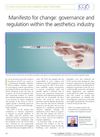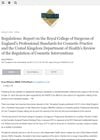Five Years After Keogh's Review of Regulation in the Aesthetics Sector, What Has Changed?
June 2018
in “
Journal of Aesthetic Nursing
”

TLDR Some improvements in the aesthetics sector have been made, but patient protection is still lacking due to no compulsory register for practitioners and non-prescription dermal fillers.
Five years after Sir Bruce Keogh's review of the regulation of cosmetic interventions, some progress has been made in the aesthetics sector, but significant gaps remain. The review, which highlighted the lack of protection for patients undergoing non-surgical procedures, led to the development of accredited qualifications by Health Education England (HEE) and standards by the General Medical Council (GMC) and the Royal College of Surgeons (RCS). However, the government did not support a central register for all practitioners, leaving a gap in patient protection. Voluntary registers have emerged, but without a compulsory register, the public remains vulnerable to unregistered practitioners. There is also a push for dermal fillers to become prescription-only, but this has not been legislated. The Cosmetic Practice Standards Authority (CPSA) is collecting data on treatment efficacy and risks, and standards are being continuously updated. Despite the incomplete progress and challenges, the situation has improved with better standards of training, practice, and supervision now available for patients to seek qualified practitioners.




